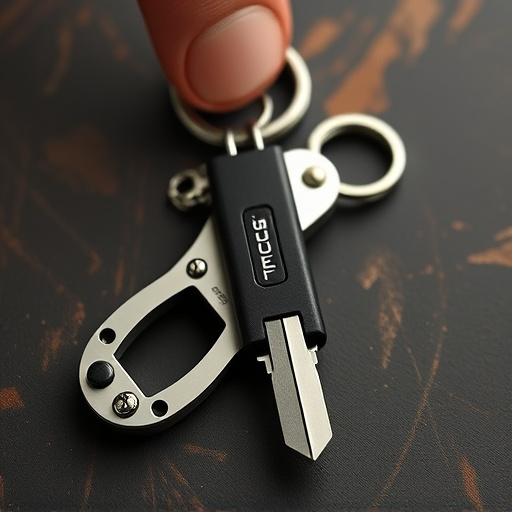When designing metal keychains focused on discrete protection, opt for strong materials like stainless steel or titanium. Prioritize ergonomics for user comfort and quick access, integrating textured finishes or weaves for visual disruption without sacrificing structural integrity. Incorporate security features such as alarms and magnetic locks to deter theft, and use advanced alloys to enhance cutting and prying resistance. The ideal design balances compactness, discretion, functionality, and security, ensuring peace of mind while keeping keys safe and within reach.
Looking to enhance your daily carry with a robust yet discreet keychain? Discover the ultimate guide to metal defense keychains, exploring design tips that balance strength, comfort, and security. From material selection for optimal durability and secrecy to ergonomic features ensuring easy accessibility, we’ll navigate you through every critical aspect. Learn how to incorporate advanced security measures to deter theft while considering size and portability for seamless everyday use. Elevate your keychain game with these expert recommendations on discrete keychain protection devices.
- Choosing Materials for Optimal Strength and Discreteness
- Ergonomic Design for Easy Access and Comfort
- Incorporating Security Features to Deter Theft
- Size and Portability Considerations for Everyday Use
Choosing Materials for Optimal Strength and Discreteness
When designing a metal defense keychain, selecting the right materials is paramount for achieving both strength and discreteness. Opt for high-quality metals like stainless steel or titanium, renowned for their exceptional durability and resistance to wear and tear. These materials offer robust protection while maintaining a sleek profile, ensuring your keychain remains subtle yet secure. Avoid overly thick materials that can compromise the keychain’s portability; balance is key to creating a discreet defense tool.
Consider the ultimate goal: providing discrete keychain protection devices. Incorporate features like textured finishes or innovative weaves to disrupt the overall appearance without sacrificing structural integrity. These techniques add visual interest while maintaining the keychain’s low-profile appeal, making it an unassuming yet powerful self-defense accessory.
Ergonomic Design for Easy Access and Comfort
When designing a metal defense keychain, one of the key considerations is ensuring an ergonomic grip for effortless access and user comfort. The keychain should fit comfortably in the hand, allowing users to quickly retrieve their keys without strain or discomfort. A well-designed grip can make all the difference in situations where quick access to your keys is vital.
Ergonomic features such as a textured surface or contoured design not only enhance grip but also prevent the keychain from slipping out of hands. These simple additions can transform a mundane key chain into a reliable, discreet protection device that offers peace of mind. By prioritizing ergonomics, you create a functional accessory that seamlessly integrates into daily routines without compromising on security.
Incorporating Security Features to Deter Theft
Incorporating security features into your keychain design is a smart move to deter theft and ensure the safety of your keys. Metal keychains can benefit from various discrete protection devices that serve as effective deterrent measures. One such feature is a built-in alarm system; when unauthorized access is attempted, a loud alarm can startle potential thieves and alert nearby individuals. Another option is magnetic locking mechanisms that require a unique code or combination to open, adding an extra layer of security.
Additionally, incorporating advanced materials like steel or reinforced metal alloys can make keychains more resistant to cutting or prying, making them less appealing targets for opportunistic thieves. These discrete keychain protection devices blend functionality and security seamlessly, allowing users to carry their keys with peace of mind, knowing their personal belongings are safeguarded from unwanted takers.
Size and Portability Considerations for Everyday Use
When designing a metal defense keychain for everyday use, size and portability are key factors. The device should be compact enough to fit comfortably in your pocket or bag, ensuring it’s always within reach when you need it. A well-designed, small keychain offers discreet protection without compromising functionality—it should still easily attach to your keys and be secure enough to deter would-be thieves.
Consider the balance between a minimal, lightweight design that adds little bulk to your daily carry and one that provides robust security features. The right size should allow for easy handling while also housing essential components like a robust lock mechanism. This delicate equilibrium ensures you have a reliable Discrete Keychain Protection Device that enhances your safety without becoming a nuisance.
When designing a metal defense keychain, balancing strength, discreteness, and ease of use is key. By selecting high-quality materials, implementing ergonomic features, and adding security enhancements, you can create a powerful yet portable protection device. Remember to consider size and portability for everyday carry, ensuring it fits seamlessly into your lifestyle without compromising functionality. With these tips in mind, you’re well on your way to crafting a discrete keychain that offers superior protection.
